

Metal detecting holidays in England with the World's most successful metal detecting club.
Twinned with Midwest Historical Research Society USA
|
March
2005 finds |
|
Updated 4th May Comments on Roman coins are kindly supplied by the Mark Lehman at the Uncleaned Roman forum Comments on the Celtic coin finds are kindly supplied by Philip de Jersey at the Celtic Coin Register Comments on the Saxon coins are kindly supplied by Martin Allen at the Cambridge Museum |
 |
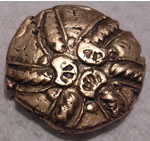 |
|
Addedomaros 37 - 33 BC found by Dakota Dennis 'a very nice example of the Addedomaros spiral stater, VA 1620. Lots of them about now (150 plus) but this is a very decent example - though as usual without a trace of the reverse inscription, all off the edge of the flan. VA's dating is a bit unrealistic, I would suggest anywhere between 45 and 30 BC, but certainly a little later than the Gallo-Belgic stater you recorded before. This one will be CCI 05.0196. |
|
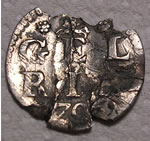 |
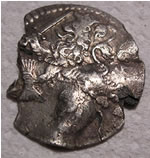 |
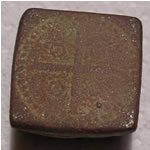 |
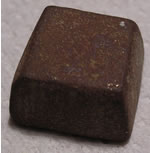 |
|
Dutch Gelderland
1709/8 Silver Ducat (48 Stuivers) Mint Mark Knight on horse |
17thC Portuguese
Coin weight - P Withers |
||
 |
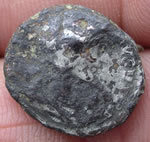 |
 |
 |
|
Early 1600's silver button found by Dakota Lowell. Reported as treasure |
Roman
silver |
George
1st London trade weight |
1340
AD Bronze beehive thimble |
  |
 |
||
|
1819
George III, 1832 William IV and Victoria 1845 milled silver sixpences
|
Alnage
seal, 17th/18thC gaming token, Russian bale seal, 17thC navy traders token,
Hallmarked cloth seal with Crown
|
||
 |
 |
||
|
GLORIA
EXERCITVS - soldiers flanking single
legionary standard - of some member of the family of Constantine and so dates to about 335-340 A.D |
'Tetricus
I, 270-273 A.D. and appears to be Spes advancing left holding flower and hitching skirt - Cf. Sear RCV, 3181' |
||
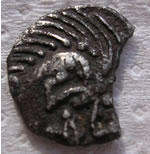 |
 |
 |
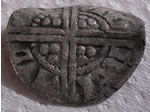 |
|
Saxon C600 - 775 AD Silver Sceattas Porcupine Type 0.94g, 12mm Your 'sceat' is a very interesting mule with designs derived from the Series E plumed bird type and the Series D cross pommee reverse. This is a good example of the copying of designs in this coinage, which often resulted in rather garbled copies. |
1216 Henry
III voided long cross hammered silver 1.3g, 19mm |
||
 |
 |
 |
|
|
1216 AD Henry
III voided long cross half penny and a 1500's Elizabeth 1st one pence
|
1272
AD Edward 1st penny
|
||
 |

|

|
|
 |
|||
|
Victoria
1860 three pence, 1852 Victoria
six pence and George VI 6 pence
|
17thC
Clothing fastener |
18thC
silver thimble |
|
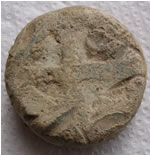 |
 |
 |
 |
|
15thC
Long cross trade weight |
1696
William III silver love token |
Russian
bale seal |
|
 |
 |
 |
 |
|
'unfortunately,
one can't even see if there is a laurel wreath or diadem that might help with vague dating. My first impression is that it's post-Constantinian, but that's in the realm of "clarevoyant attribution" rather than being based on any firm evidence' |
'This
appears at first glance to one of two possible coins - either an early
Byzantine-era pentanummium (c. 525 A.D.), or a fragment (or barbarous
imitation) of a centenionalis of Constantius II or Magnentius (c. 350-355 A.D.) with a large Chi-Rho (X + P) monogram style Christian symbol on the reverse'. |
Looks
like an armour piercing cross bow bolt - needs further research |
|
 |
 |
 |
|
|
Unusual
15thC half groat sized lead token |
1696
William III silver sixpence - Bristol mint
|
||
 |
 |
 |
 |
|
Spur rowell
- looks , modern |
Cleaning
bullet ? |
Post Medieval
mount |
|
 |
 |
 |
|
|
Charles 1st
hammered silver one pence
|
17thC
bell clapper
|
||
 |
 |
 |
|
|
Lead carriage
crest |
18/19thC
silver mount
|
Early Customs
button |
|
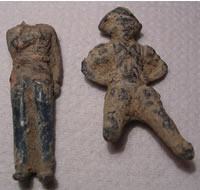 |
 |
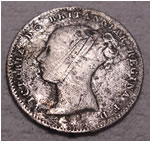 |
|
|
Figure left
Napoleon lead soldier, found on a Napoleonic prisoner of war site
|
Victoria
1860 - milled silver 3 pence
|
||
 |
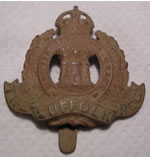 |
 |
 |
|
Great find
- Crotal bell with wheat growing throught it and the guy pull it out by
the stalk LOL |
Suffolk Reg
cap badge |
1766 Russian
bale seal
|
|
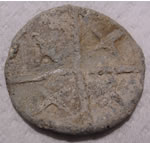 |
 |
 |
 |
|
15thC lead
token |
1812
Russian bale seal
|
Alnage
cloth seal |
|
 |
 |
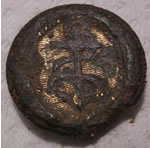 |
 |
|
1575 Snake
belt fitting |
1340
AD Bronze beehive thimble |
post 1775
Navy button |
15thC lead
token |
 |
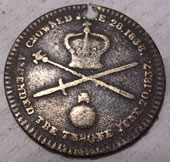 |
 |
 |
|
Victorian
Coronation medallian June 26th 1838
|
Unknown copper
coin |
Lion with
Castle livery button |
|
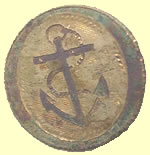 |
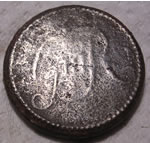 |
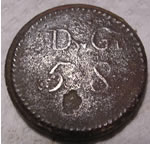 |
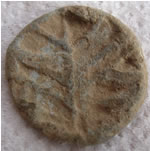 |
|
post 1775
Navy button |
George III Bullion weight mid 1700's GIIIR - D G 5.8 refers to pennyweights and grains N.Biggs |
15thC lead
token |
|
 |
 |
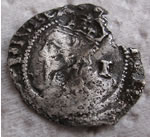 |
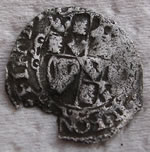 |
|
Charles 1st
half groat( 2 pence) hammered silver
|
Charles
1st hammered silver one pence
|
||
 |
 |
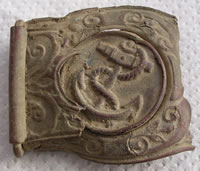 |
|
|
1575 Elizabeth
1st hammered silver half groat |
Excellent
find, pre 1850 Large Navy belt buckle
|
||
 |
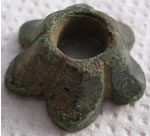 |
 |
 |
|
Post 1795
Artillery button in great shape |
15thC knife
pommel |
1946 George V Florin (24 pence) Last year of the silver coins |
|
 |
 |
 |
|
|
Great find
- large complete bell with makers mark T. Probably a sheep bell c 1700's |
Royal Artillery
Cap badge
|
1795 Captains
button |
|
 |
 |
 |
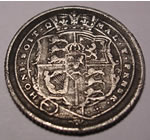 |
|
Large Roman in great shape 11.97g - 30mm Neronian VICTORIA AVGVSTI S C dupondius 'It would date to 50 AD to 68 AD based on date of minting but keep in mind that by the time the coin traveled all the way to Britain and acquired as much wear as it enjoys, it was probably deposited in that field where your guy found it 20 to 30 years later and possibly as late as Hadrian's time (117 AD plus.) (These things circulated a long time sometimes.) The rarity of the coin is certainly in the "scarce" category' |
1816 George
III milled silver sixpence - 2.72g 20 mm
|
||
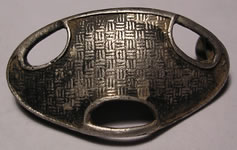 |
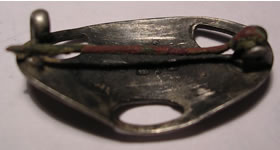 |
||
|
Neat find,
Chester hallmark 1890 silver brooch - 2.12g
|
|||
 |
 |
 |
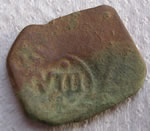 |
|
Facinating
solid bronze button 18thC - 14.14g 26mm |
1641 with
Crown, VIII
|
||
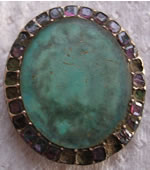 |
 |
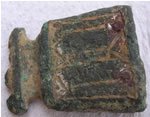 |
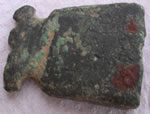 |
|
Gold Ring
fragment with emeralds - reported as possible treasure - no hallmarks
|
Medieval
single loop oval buckle with an integral box chape
|
||
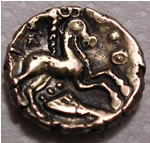 |
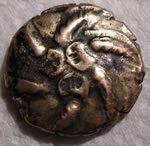 |
 |
 |
|
Addedomaros Celtic full stater 45 to 30 BC found by Palatine Bob 5.56g 17mm CCI 05.0211 |
Large horse
harness brass with farmers initials |
Several really
nice early Crotal bells turning up |
|
 |
 |
||
|
Large Civil
war 1640's Caronade stone cannon shell, great eyeball find by Veggie Mary
|
Complete
17thC Jews harp
|
||
 |
 |
||
|
4thC Roman silver RBS
ROMA / Shewolf & twins city commemorative from the mint of Lugdunum
(Lyons, France) - it would date to about 335-337 A.D. being the smaller
module issue - the larger ones (c. 18 + mm) are the ones from 'It
would have been silver-washed, originally - the alloy itself might have
contained a percent or two of silver as well, but not nearly enough
to make the coin look silvery on its own. Except for the silver or billon
argenteus of the era, there were no silver coins, per-se, in circulation
- silver-washed bronze or copper evidently filled-in as token coinage
at a good bit above its intrinsic value with the silver wash to indicate
that it took the place of silver. Unfortunately, little to nothing survives
from contemporary records and no even knows what these were called as
a denomination, or what relationship they stood to the gold and other
base denominations. Thank
to Mark at the UCR forum for the great info
|
|||
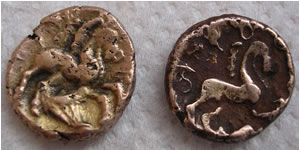 |
 |
||
|
Chicago Keith's and Chicago Ron's full Celtic staters Left example 5.64g 16mm
CCI 05.0212 |
|||
 |
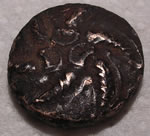 |
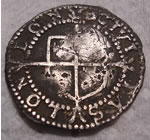 |
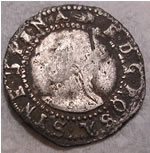 |
|
Chicago Ron's 2nd full Celtic stater 5.30g 16mm CCI 05.0267 |
1590 to 1592
Elizabeth 1st hammered silver penny - 'hand' mintmark
|
||
 |
 |
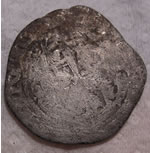 |
 |
|
1247 Henry
III long cross cut 1/4 (farthing)
|
1625 AD Charles
1st hammered silver one pence
|
||
 |
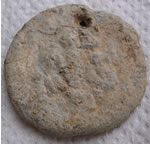 |
 |
|
|
Nice interesting
piece scripted CP or CR - Not researched it yet but coin weight size and
feel |
Large very
early Medieval bullion weight- N.Biggs |
Saxon period
clothing fastener |
|
 |
 |
||
|
1888 Birmingham
hallmarked sold silver, maker BM, name tag Violet, neat artefact
|
|||
 |
 |
 |
|
|
Post medieval
cloak fastener |
Fragment
of a bronze 1stC Roman fibular brooch |
Victorian
period butterfly brooch |
|
 |
 |
 |
|
|
Bronze ruler
fragment in inches - 17/18 th C |
Post Med
base metal brooch with glass stones |
Bronze bell
clapper
|
|
 |
 |
||
|
National Mutual Insurance 19 to 20 Charring Cross Rd London Return attached to get a 5 shilling reward - neat artefact, Victorian era |
|||
 |
 |
 |
 |
|
19thC Stag
livery button |
The Great
Eastern Railway button |
20thC Toy
lead pistol |
Book clasp
with markers mark RH |
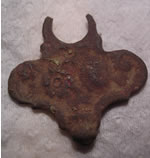 |
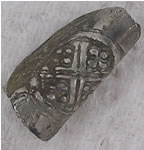 |
 |
 |
|
Georgian
period flower decorated watch winder |
1199AD King
John hammered silver short cross penny
|
16thC Elizabeth
1st hammered silver 6 pence fragment |
|
 |
 |
 |
 |
|
1694 William
and Mary penny |
1670 Ipswich
farthing
|
FVC early
military one piece button |
|
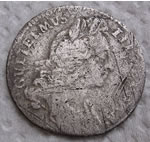 |
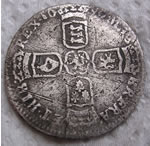 |
 |
|
|
1696 William
III milled silver sixpence - Early Harp large crown |
Post Medieval
belt mount |
||
 |
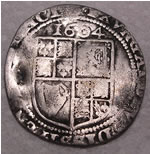 |
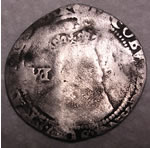 |
 |
|
Huge 16thC
decorated cow bell with markers mark |
1604 James
1st hammered silver 6 pence
|
1500's Elizabeth
1st hammered silver half groat |
|
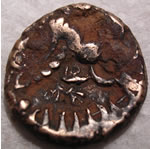 |
 |
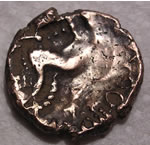 |
 |
|
Addedomaros type 45- 30 BC 17mm 5.50g not in any major reference book Canadian Rod 'This will be CCI 05.0283. What is unusual about it is that the reverse is struck quite far off-centre, so that much more of the inscription is visible than is usually the case. Although the initial A of Addedomaros is not visible (at least I can't make it out on this image), what you can see then reads DDIID working clockwise round the top of the horse - with the first two Ds represented by the Greek letter theta (so with a bar across the middle), then the II representing the fourth letter, E, then a conventional D for the next letter. And obviously the rest of the inscription would carry on round in front of the horse's head and beneath the cornucopia under the horse. It is more common to see these coins offstruck so that the lower part of the design is visible, and relatively very rare to see the early part of the inscription as you can here'. CCI 05.0283 |
Addedomaros 45- 30 BC found by Mass Linda 19 mm 5.45g CCI 05.0285 |
||
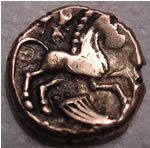 |
 |
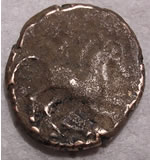 |
 |
|
Addedomaros
45- 30 BC found by Canadian
Rod 17mm 5.42g sent to CCI for logging |
Addedomaros 45- 30 BC found by Mass Linda 18 mm 5.62 g CCI 05.0286 |
||
 |
 |
 |
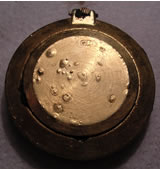 |
|
George V
1922 Milled silver half crown (30 pence) |
Heart attack
find LOL Gold plated pocket watch !!
|
||
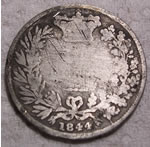 |
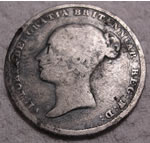 |
 |
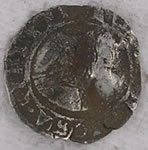 |
|
1844 Victorian
milled silver Sixpence |
Looks like
a 1500's Elizabeth the 1st hammered silver penny by the dot behind the
head but it is the size of a half groat, needs more investigation
|
||
 |
 |
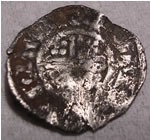 |
 |
|
14thC Edward
hammered silver penny
|
Richard 1st
1189 AD shortcross hammered silver penny
|
||
 |
 |
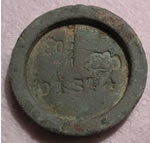 |
|
|
On first
glance a Saxon looking heart attack find LOL. Probably Victorian
|
Bronze axe
socketed axe fragment c 1250 BC |
Essex hallmarked
trade weight |
|
 |
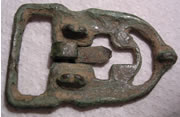 |
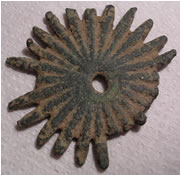 |
 |
|
Very unusual
hand made buckle unlike any design in the reference books, 6th-8th century
Byzantine
|
Huge Medieval
spur rowell |
lead coin
weight |
|
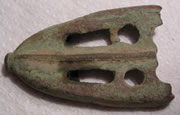 |
 |
 |
 |
|
15thC dagger
chape |
1679 Charles
II milled silver 3 pence
|
1723 Dutch
Zeelandia Duit copper |
|
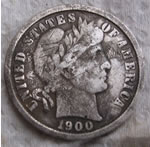 |
 |
 |
|
|
1900 USA
Barber Dime |
Group of
hammered silver coins showing sizes |
||
 |
 |
 |
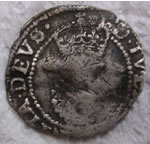 |
|
1335 - 1343
Edward III Type 3 Farthing 0.36g
|
1604 James
1st hammered silver half groat (2 pence) 0.90g |
||
 |
 |
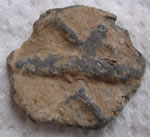 |
|
|
15thC belt
mount |
17/18thC
Musket bayonet frog |
Saxon period coin weight N.Biggs |
|
 |
 |
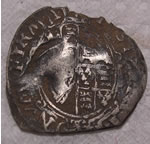 |
 |
|
Bullion cup weight used from 17thC onwards. Made in nests to fit inside each other. This type has the fittng for the hinged lid. |
Charles 1st
hammered silver half groat (2 pence)
|
||
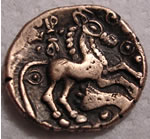 |
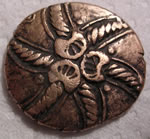 |
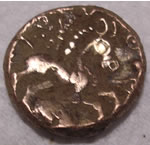 |
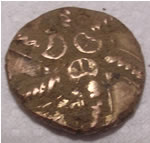 |
|
Addedomaros type 45- 30 BC - 5.53g 18mm Veggie Mike CCI 05.0290 |
Addedomaros type 45- 30 BC 5.62g 17mm Mass Linda CCI 05.0291 |
||
 |
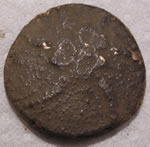 |
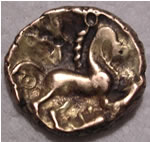 |
 |
|
Addedomaros type 45- 30 BC 5.63g17mm Mass Bruce 'The 'burnt' one is curious, can't really tell whether a lot of that will clean off or not from the image. It's interesting that so far, most of the coins are really quite worn - which suggests that these coins had been around for a while before they were buried. So subject to further finds etc, at the moment I'd guess a burial date somewhere round 20 BC, perhaps even a few years later'. CCI 05.0293 |
Addedomaros type 45- 30 BC 5.57g 16mm Mass Bruce CCI 05.0292 |
||
 |
 |
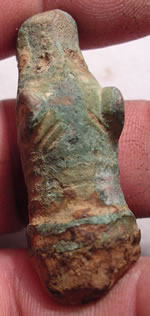 |
|
|
Roman 1st to 4thC animal head knife/dagger handle 36.81g 42mm L x 15mm W x 20mm D |
|||
 |
 |
||
|
Roman ear
scraper 30mm long |
Gilded button
with crown |
||
 |
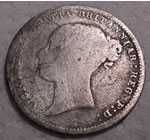 |
 |
 |
|
Early 1800's
Victorian milled silver sixpence
|
George V
1920 milled silver sixpence
|
||
 |
 |
 |
 |
|
'local
imitation of a Nero ANNONA AVGVSTA CERES sestertius in very crude style
- the portrait less so than the reverse. The portrait looks like Nero,
but he had a fairly limited group of reverse types and the only likely
possibility for a standing figure next to a seated(?) one is the Annona
type'. |
3rd
century product - of excellent style - although you show the reverse
rotated 90 or so degrees clockwise - it may also be unofficial, but
the relief is unusually high for a "barbarous radiate". The
reverse is probably meant to be a peacock flying right with a person
riding it - this is a memorial style, the peacock bearing the person
off to "heaven" or wherever. Say around 260-275 A.D. (?) I
believe would be a safe guess. I think there are coins struck posthumously
for Valerian by Gallienus with this reverse, I know there was a type
or two Valerian struck for his late wife Mariniana with a similar reverse,
but that's no woman on the obverse and women were never portrayed with
radiate crown. This is problematic, because at the time of Gallienus,
Britain was part of the Gallic empire, so you might need to look under
listings for Postumus or his successors to find a closer match
|
||
 |
 |
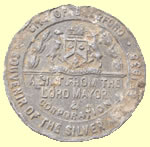 |
|
|
Great find
- complete Alnage cloth seal with both ends intact |
1910- 1935
George V silver Jubilee Medallion
|
||
 |
 |
 |
 |
|
15thC lead
token |
Early 1800's
Victorian silver sixpence
|
Nice George
2nd copper penny |
|
 |
 |
 |
 |
|
1922 George
V milled silver Florin ( 24 pence)
|
'This
coin seems to be an official, though highly worn sestertius of either
Vespasian or Titus - I think I can see "VES.." in the obverse
inscription from about 9:00-10:00. Since they both were portrayed looking
nearly alike and Titus used VESP in his inscriptions, it would be difficult
to say which of the two it is from your photo, but you could fairly safely
date this to the 60's & 70's A.D'. |
||
 |
 |
 |
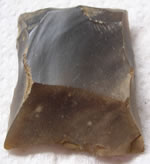 |
|
1942 George
VI milled silver sixpence
|
Great eyeball
find 17/18thC Musket flint
|
||
 |
 |
 |
 |
|
1199 AD King
John hammered silver shortcross cut half Class 5b
|
17thC Bale
seal with M design |
18thC shoe
buckle |
|
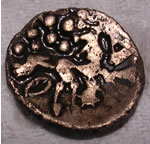 |
 |
 |
 |
|
Trinovantes Clacton Celtic gold 1/4 stater 50 BC 1.29g 14mm CCI 05.296 'yet another very interesting coin. This is a Clacton quarter stater, unlisted in Van Arsdell but in the British Museum catalogue (in the wrong place, with the Corieltauvi) as BMC 192, and in 'Coins of England' as no. 42. These coins were almost unknown in the late 1980s, but there are now about 60 of them recorded here, mostly from Essex and Suffolk. The reverse design is basically the same as the better-known Clacton stater (VA 1455), while the obverse has yet another interpretation of the three men in a boat design, here with two 'men', and sometimes looking like a human face. Unfortunately not readily visible on this one, though you should be able to pick out the outline of the boat. Of those 60 or so examples, possibly as few as two are struck from the same reverse die as this coin, which has several large flaws and is probably from late in the series (as the use of a nearly plain obverse die also suggests). Both of the earlier two coins came from Suffolk, one from Ipswich and the other near Alderton. The type probably dates to c. 50 BC and was definitely a production of the Trinovantes. |
1816 George
III sixpence
|
||
 |
 |
 |
 |
|
1853 Victorian
milled silver six pence |
Medieval lead cross and pellet 2oz trade weight Ref N. Biggs |
||
 |
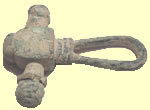 |
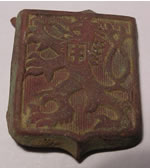 |
 |
|
18thC shoe
buckle |
16thC purse
bar swivel |
19thC Lion
and crest leather mount |
Geogian period
silver buckle fragment |
 |
 |
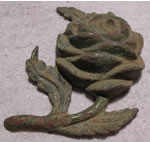 |
 |
|
18thC chest
key |
17thC chest
key |
19thC Rose
design mount |
Two Grouse
livery button |
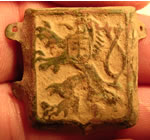 |
 |
 |
 |
|
Another 19thC
Lion and crest leather mount |
Hound design
livery button |
Lion design
livery button |
19thC button |
 |
 |
 |
|
|
Winged bird
livery button |
Crown design
Military button |
Lion deisgn
gilded button |
|
